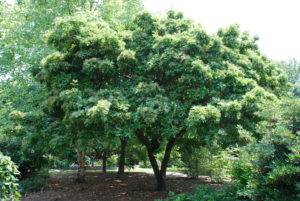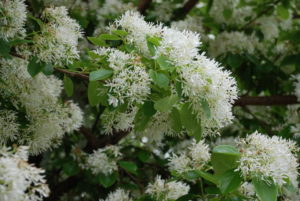Chinese fringetree (Chionanthus retusus) is native to China, Korea and Japan (Zone: 6 to 9a). Related to native U.S. species (C. virginicus), fringetrees are noted for their profuse spring bloom of fragrant white flowers. It is most often seen in cultivation as a large, multi-stemmed, deciduous shrub growing to 15 – 20 feet tall with a rounded, wide-spreading form. It also may be grown as a small to medium tree (multi-trunked or trained as a single trunk), maturing to 30 – 40 feet tall.
In late spring, terminal clusters pure white 4 inch flowers are mildly fragrant. It flowers about 1-2 weeks earlier than native fringetree. Plants are primarily dioecious (separate male and female plants), but may bear some perfect flowers. Male flowers tend to be slightly larger.
Female flowers bear clusters of ½ inch long olive-like fruits that ripen to bluish black in late summer/fall and serve as a good food source for birds and other wildlife. Lustrous, leathery oval to round leaves are bright green above and ashen green and downy beneath. Leaves turn yellow in fall (reportedly more attractive in northern areas). Glossy gray-brown bark on young trees exfoliates in thin curls and is an attractive winter feature.
All fringetrees bloom best in full sun to part shade and in average, medium moisture, well-drained soil. Foliage is tolerant of air pollution and adapts well to urban settings. It exhibits good drought tolerant once planted for one year. Irrigation over long dry spells lasting many weeks is highly recommended.
Chinese fringetree has no serious insect or disease problems. Occasionally, mites, scale, and borers maybe problems, particularly when planted on an inhospitable site.
‘Tokyo Tower’ is a unique columnar small flowering tree. Branching habit is very fastigiate (upright). On species trees, pruning is performed after flowering. Tokyo Tower rarely needs pruning, other than to maintain its unique stove-pipe appearance.



 Posted in
Posted in 
